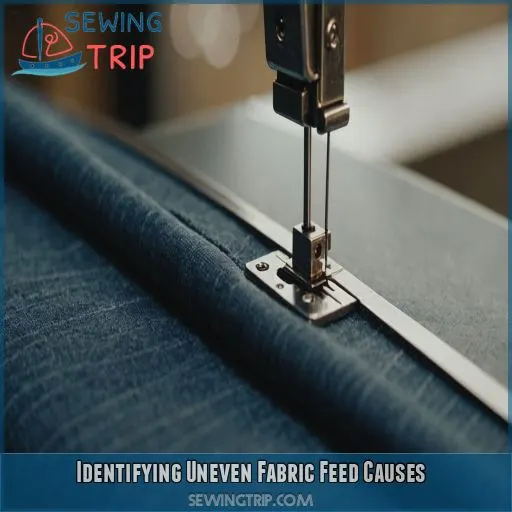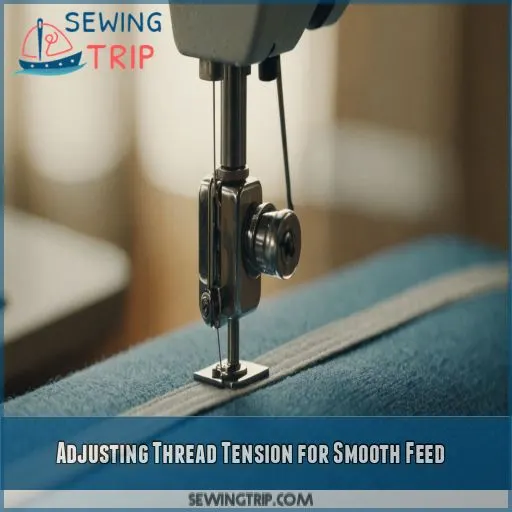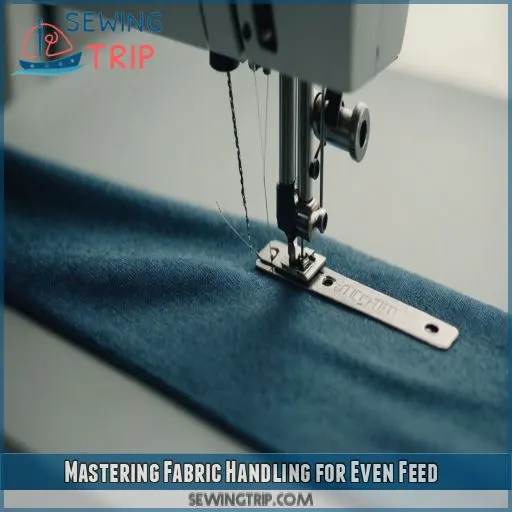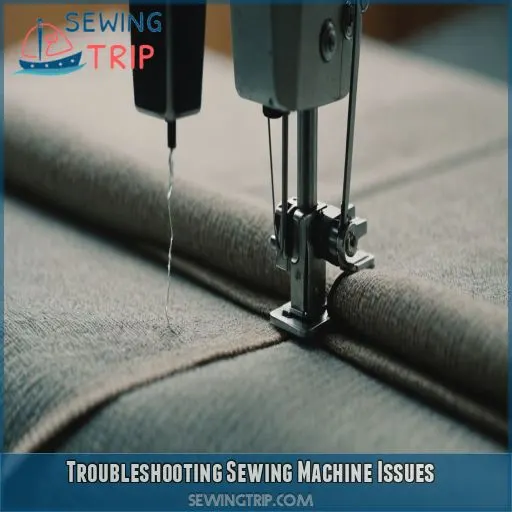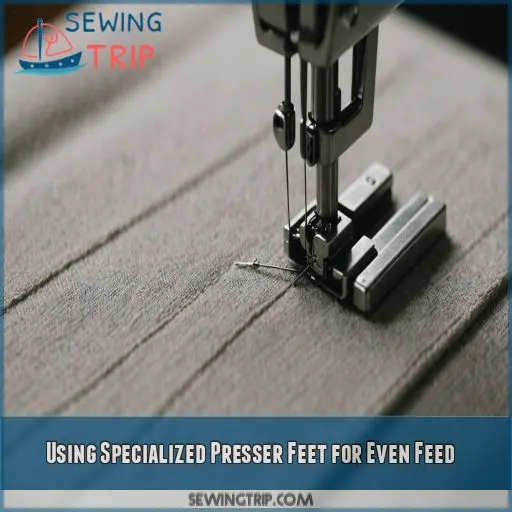This site is supported by our readers. We may earn a commission, at no cost to you, if you purchase through links.
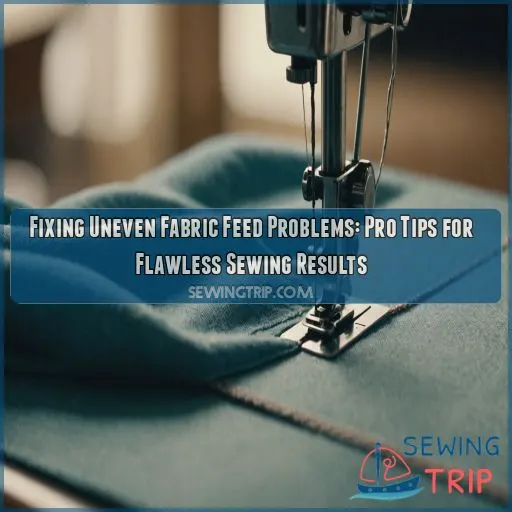
Don’t worry, you’ve got this!
To tame the fabric beast, start by checking your thread tension.
It’s often the culprit behind uneven fabric feed.
Adjust the upper and lower tension to achieve a perfect balance.
Next, make sure your fabric is properly aligned and smoothly fed through the machine.
If your machine is acting up, identify and replace worn-out parts or give it a good cleaning.
Table Of Contents
Key Takeaways
- You’ve got the power to tame the fabric beast! Start by checking your thread tension, as it’s often the culprit behind uneven fabric feed. Adjust your upper and lower Thread Tension to achieve a perfect balance, and don’t be afraid to experiment until you get it just right.
- It’s time to get a grip on your fabric – literally! Mastering fabric handling techniques is crucial for even feed. Focus on consistent fabric tension, proper fabric alignment, and gentle yet firm control. Remember, you’re the boss, and your fabric should behave accordingly!
- Don’t let sewing machine malfunctions get in the way of your sewing flow! Identify and replace worn-out parts, give your machine a good cleaning, and consider updating or replacing it if necessary. With a well-oiled machine, you’ll be sewing like a pro in no time.
- Your presser foot is your best friend when it comes to achieving even fabric feed! Choose the right specialized presser foot for your fabric type, whether it’s a walking foot, even feed foot, Teflon foot, or roller foot. Experiment with different feet and techniques until you find the perfect match for your project.
Identifying Uneven Fabric Feed Causes
You’re sitting at your sewing machine, watching in frustration as your fabric feeds unevenly. You’re probably wondering what’s causing the problem—and how to fix it.
Uneven fabric feed can be caused by a variety of factors.
These include:
- Incorrect thread tension
- Improper fabric handling
- Sewing machine malfunctions
- Fabric type and weight considerations
- Needle and presser foot incompatibilities
Incorrect Thread Tension Issues
Uneven fabric feed got you frustrated? Don’t worry, friend! Let’s tackle thread tension issues first. Check your tension gauge to make sure it’s not too tight or loose. Bobbin winding can also be a culprit – make sure it’s not twisted or uneven. Adjust your upper and lower thread tension accordingly, and you’ll be sewing smoothly in no time.
Improper Fabric Handling Techniques
Don’t let improper fabric handling techniques ruin your sewing flow! Fabric slippage, wrinkled fabric, and fabric bunching can be frustrating. To avoid these issues, check your fabric handling skills. Here are 4 key areas to focus on:
- Consistent fabric tension: Keep the fabric taut, but not too tight.
- Proper fabric alignment: Align the fabric with the machine’s guides.
- Feed dog pressure: Adjust the feed dog to match your fabric type.
- Gentle fabric handling: Handle the fabric smoothly, without tugging or pulling.
Sewing Machine Malfunctions and Issues
Now that we’ve tackled improper fabric handling, let’s get to the root of the problem – your sewing machine. Is it making a weird noise? Are you experiencing bobbin winder issues, needle breakage, or skipped stitches? Maybe the feed dog is jammed? These malfunctions can cause uneven fabric feed, but don’t worry, we’ll troubleshoot them together!
Fabric Type and Weight Considerations
Now that we’ve tackled sewing machine malfunctions, let’s talk fabric! The type and weight of your fabric can greatly impact your stitch quality. Heavier fabrics require larger needles, longer stitch lengths, and adjusted thread tension. Conversely, lighter fabrics need smaller needles and shorter stitch lengths. Choose the right thread and adjust your tension accordingly for smooth, even feed.
Needle and Presser Foot Incompatibilities
Now that you’ve considered your fabric type and weight, let’s talk about needle and presser foot incompatibilities. This is where things can get a bit tricky. Here are some potential mismatch scenarios to watch out for:
- Using a thick needle with a delicate presser foot
- Pairing a heavy fabric with a standard presser foot
- Mixing a sharp needle with a Teflon foot
- Combining a long stitch length with a small needle size
Adjusting Thread Tension for Smooth Feed
Now that you’ve identified the causes of uneven fabric feed, it’s time to get your thread tension in check – after all, you can’t have smooth sailing without properly balanced threads. By understanding thread tension basics and learning how to adjust upper and lower thread tension, you’ll be well on your way to achieving that perfect, even feed (Source).
Understanding Thread Tension Basics
Now that you’ve identified the culprits behind uneven fabric feed, let’s get to the nitty-gritty of thread tension. Think of thread tension as the referee in your sewing game – it keeps everything in balance. Mastering thread tension basics is key. Familiarize yourself with tension gauges, types (static, dynamic, and disc), and tools (tension discs, springs, and more).
Adjusting Upper and Lower Thread Tension
Now that you’ve got a handle on thread tension basics, it’s time to fine-tune your machine. Adjusting upper and lower thread tension is a balancing act. Use a tension gauge to achieve balanced tension. Refer to your thread tension chart for guidance. For troubleshooting, tweak the upper thread tension first, then adjust the lower thread tension to match.
Using Automatic Thread Tension Features
You can rely on automatic thread tension features to simplify the process. Many modern sewing machines come equipped with automatic tension settings, tension dial calibration, and tension memory features (Source). These features help you get consistent thread tension, reducing the risk of uneven fabric feed. By using automatic tension, you’ll enjoy benefits like improved stitch quality and reduced thread breakage (Source).
Manual Thread Tension Adjustment Techniques
Now it’s time to get hands-on with manual thread tension adjustment. You’ll need a tension adjustment tool, usually a small screwdriver or dial. Gently turn the dial clockwise to tighten or counterclockwise to loosen. Check your thread’s tension basics and look out for common issues like puckering or breakage. Your sewing machine’s manual is also a great tension troubleshooting guide.
Mastering Fabric Handling for Even Feed
You’re one step closer to achieving those flawless sewing results, now that you’ve adjusted your thread tension, it’s time to master fabric handling for an even feed. By learning how to properly guide, grip, and manage your fabric, you’ll be able to tackle even the most finicky materials with confidence and precision.
Using Fabric Guides and Attachments
Now that you’ve got your thread tension under control, it’s time to bring in the big guns: fabric guides and attachments. These nifty tools help you tame unruly fabrics and achieve a smooth feed. Here are three guide types to get you started:
- Edge guides: Attach to your sewing machine’s presser foot to keep fabrics aligned and prevent bunching.
- Center guides: Useful for wider fabrics or projects requiring precise centering.
- Adjustable guides: Offer flexibility for various fabric widths and types.
Implementing Proper Fabric Gripping Techniques
Now that you’re using fabric guides and attachments, let’s get a grip on your fabric – literally! To implement proper fabric gripping techniques, focus on gentle yet firm control. For slippery fabrics like silk or cotton, use a little extra grip pressure. For thicker fabrics like denim, ease up to avoid bunching. Adjust your machine’s tension accordingly.
Managing Fabric Bulk and Thickness
When working with thick or bulky fabrics, it’s like wrestling a stubborn partner – you need to take control. To manage fabric bulk and thickness, try these techniques:
- Use clips or weights to hold fabric layers in place
- Adjust seam allowance to accommodate bulkier fabrics
- Employ specialized sewing techniques, like pivot stitching or binding
- Make tension adjustments to prevent fabric drag
Working With Delicate or Stretchy Fabrics
When working with delicate or stretchy fabrics, it’s like handling a fragile pet – you need to be gentle yet firm. To master even feed, try these tips:
| Fabric Type | Pinning Method | Stitch Selection |
|---|---|---|
| Delicate | Use thin pins, space 1/4" apart | Short, narrow stitches (1.5-2mm) |
| Stretchy | Use ballpoint pins, space 1/2" apart | Medium-width stitches (2.5-3mm) with stretch needle |
| Sheer | Use silk pins, space 1/8" apart | Narrow, short stitches (1-1.5mm) with sharp needle |
Troubleshooting Sewing Machine Issues
Now that you’ve mastered fabric handling, it’s time to tackle the next potential culprit behind uneven fabric feed: your trusty sewing machine. Whether it’s a worn-out part, a clogged interior, or an outdated model, we’ll walk you through the troubleshooting process to get your machine humming and your fabric feeding smoothly.
Identifying and Replacing Worn-Out Parts
Now that you’ve mastered fabric handling, let’s tackle those pesky sewing machine issues! Worn-out parts are common culprits behind uneven fabric feed. Check your machine’s manual for a replacement guide and troubleshooting tips. Regular preventative maintenance can save you from future headaches. Identify worn-out parts, and swap them out for new ones – your machine (and fabric) will thank you!
Cleaning and Maintaining the Sewing Machine
Now that you’ve replaced those worn-out parts, it’s time to give your sewing machine some TLC. Regular cleaning and lubrication will keep it running smoothly. Use a soft brush and cleaning tools to remove lint and debris, then apply a few drops of sewing machine oil. Don’t forget to clean the bobbin area and take care of that needle!
Updating or Replacing the Sewing Machine
Time to face the music – your trusty sewing machine might be the culprit behind uneven fabric feed. If cleaning and maintenance didn’t do the trick, it’s time to think about updating or replacing it. Here are three things to keep in mind:
- Budget considerations: Set a budget and stick to it – sewing machine models vary greatly in price.
- Warranty options: Look for machines with good warranties that cover repairs and replacements.
- Shopping around: Compare prices online and in local shops to find the best deal for your needs.
Using Sewing Machine Accessories and Attachments
Now that you’ve updated or replaced your sewing machine, it’s time to supercharge it with accessories and attachments.
Think of them as special tools in your sewing toolbox.
Using the right sewing machine feet, like a walking foot or free-motion embroidery foot, can make a huge difference in achieving even fabric feed.
Experiment with different attachments for quilting and other techniques to get the most out of your machine.
Using Specialized Presser Feet for Even Feed
You’re just a step away from achieving perfectly even fabric feed – and it all starts with choosing the right specialized presser foot for your sewing project. By understanding the different types of presser feet and their uses, you’ll be able to tackle even the most stubborn fabrics with confidence and ease.
Understanding Presser Foot Types and Uses
Let’s get a grip on presser feet! Choosing the right one can make all the difference in achieving even fabric feed. Here are three key things to keep in mind:
- General-purpose feet: Best for everyday sewing, these feet are designed for medium-weight fabrics.
- Specialty feet: For specific tasks like quilting, gathering, or zipper insertion.
- Interchangeable feet: Allow for easy switching between different feet and fabrics.
Using Walking Foot and Even Feed Foot
Uneven fabric feed can be a real pain, right?
You need the right presser foot to tame those tricky fabrics.
A walking foot is your go-to for thick or slippery materials.
An even feed foot is perfect for delicate or stretchy fabrics.
Make sure the foot you choose is compatible with your sewing machine.
With the right foot, you’ll be sewing like a pro in no time!
Implementing Teflon Foot and Roller Foot
Time to get slippery with the Teflon foot and rolling with the Roller foot. These specialized presser feet can help you conquer uneven fabric feed. Here’s how to use them:
- Use the Teflon foot for sticky or delicate fabrics like vinyl or silk.
- Choose the Roller foot for thick or heavy fabrics like denim or canvas.
- Make sure your sewing machine is compatible with these feet.
- Refer to your machine’s foot selection guide for proper installation.
Customizing Presser Foot for Specific Fabrics
=============================================
Time to get personal with your presser foot! For flawless sewing results, you need a foot that understands your fabric’s unique needs. Check out this cheat sheet to find your perfect match:
| Fabric Type | Presser Foot Recommendation |
|---|---|
| Lightweight fabrics (cotton, silk) | Teflon foot or roller foot |
| Heavyweight fabrics (denim, canvas) | Walking Foot or even feed foot |
| Stretchy fabrics (knit, spandex) | Teflon foot or specialized stretch foot |
| Delicate fabrics (lace, tulle) | Roller foot or walking foot with reduced pressure |
Adjust or DIY your presser foot to suit your fabric’s weight and texture. Happy sewing!
Frequently Asked Questions (FAQs)
How can I adjust the presser foot pressure for optimal feed?
Think of your presser foot like a dance partner – it needs to move in harmony with your fabric. Adjust the pressure by loosening or tightening the screw, and test it until you find the perfect ‘dance step’ for smooth feeding.
What causes fabric to pucker while sewing and how to fix it?
Don’t let puckering fabric get you down! You can fix it by adjusting your stitch length, using a walking foot, or employing a Teflon foot to reduce drag. Easy peasy, right? Just tweak and sew!
Can I use different types of thread for the top and bobbin threads?
You can use different types of thread for the top and bobbin threads. In fact, using a thinner, lighter bobbin thread can help with tension issues. Just make sure the threads are compatible with your machine and fabric.
How do I know if my feed dogs are worn out and need replacement?
Did you know that worn-out feed dogs can cause up to 30% of sewing machine problems? Check yours by looking for rounded or smooth edges – if they’re not sharp, it’s time to replace them for smooth fabric feeding!
What are the benefits of using a walking foot attachment for even feed?
You’ll love using a walking foot attachment! It helps you master even feed, prevents bunching, and gives you control over thick or slippery fabrics . Say goodbye to uneven stitches and hello to professional-looking results .
Conclusion
Imagine sinking your teeth into a perfectly crafted sewing project, every stitch a reflection of your skill and patience.
Now, that’s a sweet victory!
By mastering the art of fixing uneven fabric feed problems, you’ll be well on your way to flawless sewing results.
You’ve learned to tame the fabric beast by adjusting thread tension, handling fabric with finesse, and troubleshooting sewing machine issues.
Fixing uneven fabric feed problems is now your superpower – go sew like the wind!

